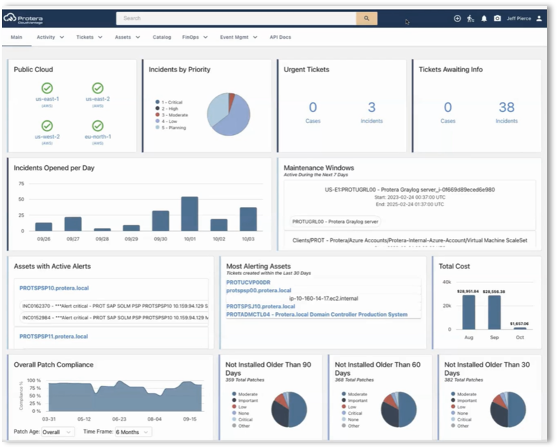01
Discover
We run collaborative workshops with your team to understand requirements, define goals, and build a prioritized backlog for automation initiatives.
Output: Automation initiative backlog
SAP BASIS has long been the fabric that enables SAP interoperability between applications, databases, services, and more. But exceptional management of today's modern SAP ecosystems requires more than just BASIS administration, you need specialized support for security, integrations, and innovative services like BTP and Cloud ALM. Protera's end-to-end support model enables you to efficiently run, optimize, and transform your critical SAP landscapes.
Our SAP consultants have experience across cloud platforms and SAP versions, expertly managing your SAP environment. Running S/4 HANA, SAP Cloud ERP, ECC? All of the above. We've got you covered.
24x7 service delivery means your systems are always proactively supported in an attrition-proof model. Our global coverage and advanced SAP monitoring ensure your systems are performing optimally, secure, and available.
SAP powers your business. With Protera providing SAP technical services, your internal teams can focus on SAP projects and strategic enhancements to increase SAP's value across your enterprise.
Protera SAP engineers monitor and tune your SAP landscape to keep systems performing at peak efficiency, expertly executing a range of daily tasks including log reviews, load balancing, and troubleshooting.
Our goal is to manage SAP performance so that it exceeds user expectations. To this end, our services have realized an average of 40% reduced downtime for common tasks such as kernel upgrades and patching. Proactive by nature, your SAP team regularly analyzes the health of the SAP ecosystem and infrastructure allocations to ensure that your cloud landscape accommodates SAP workload requirements and optimal performance.
End-to-end support including SAP BASIS administration, database support, O/S support, patching, cloud, compute, storage, and network.
24x7x365 incident management, service request management, capacity management, and change management, with full visibility in CloudVantage.
Security monitoring, endpoint detection and response, backups, DR, vulnerability scanning, and compliance recommendations.
Trusted advisor for strategic business planning, with detailed reporting, project support, FinOps, and security governance.

We use Protera Watchdog [advanced automation & monitoring] for automated stopping and starting, automated patches, and to identify immediate tasks my team needs to perform on our SAP systems in the cloud. - IT Director, Blue Diamond Growers
.png?width=800&height=67&name=customer-quote%20(1).png)
Our UX platform includes Watchdog for SAP, which enables visibility and actionable alerting on essential business processes and workloads—set to your specific thresholds to eliminate “noise.”

Cloud & UX Platform
Protera developed an industry-leading cloud and customer experience platform, CloudVantage, which incorporates automation and AI to deliver actionable performance insights, integrated security, and service orchestration across private and public clouds.
.png)
Partner, Not Provider
Protera establishes a true partnership with our clients—we strive to become an extension of your IT team. We are not “order-takers”—we believe in proactive governance of your landscapes. Our focus is to ensure that IT powers your business growth and that your users’ overall experience with IT is a positive one.




We run collaborative workshops with your team to understand requirements, define goals, and build a prioritized backlog for automation initiatives.
Output: Automation initiative backlog
Our team executes against the jointly-defined backlog using an agile, sprint-based approach to quickly deliver incremental value with visibility into progress.
Output: Automation enabled via agile delivery model
Regular sessions to review progress, reprioritize tasks, and incorporate new requirements for both DevOps automation and operational procedures.
Output: Critical tasks appropriately prioritized
We run collaborative workshops with your team to understand requirements, define goals, and build a prioritized backlog for automation initiatives.
Output: Automation initiative backlog
Our team executes against the jointly-defined backlog using an agile, sprint-based approach to quickly deliver incremental value with visibility into progress.
Output: Automation enabled via agile delivery model
Regular sessions to review progress, reprioritize tasks, and incorporate new requirements for both DevOps automation and operational procedures.
Output: Critical tasks appropriately prioritized




Client Stories & Helpful References
We run collaborative workshops with your team to understand requirements, define goals, and build a prioritized backlog for automation initiatives.
Output: Automation initiative backlog
Our team executes against the jointly-defined backlog using an agile, sprint-based approach to quickly deliver incremental value with visibility into progress.
Output: Automation enabled via agile delivery model
Regular sessions to review progress, reprioritize tasks, and incorporate new requirements for both DevOps automation and operational procedures.
Output: Critical tasks appropriately prioritized
We run collaborative workshops with your team to understand requirements, define goals, and build a prioritized backlog for automation initiatives.
Output: Automation initiative backlog
Our team executes against the jointly-defined backlog using an agile, sprint-based approach to quickly deliver incremental value with visibility into progress.
Output: Automation enabled via agile delivery model
Regular sessions to review progress, reprioritize tasks, and incorporate new requirements for both DevOps automation and operational procedures.
Output: Critical tasks appropriately prioritized
From SAP BASIS administration to network and security, we've got you covered. Let's chat.